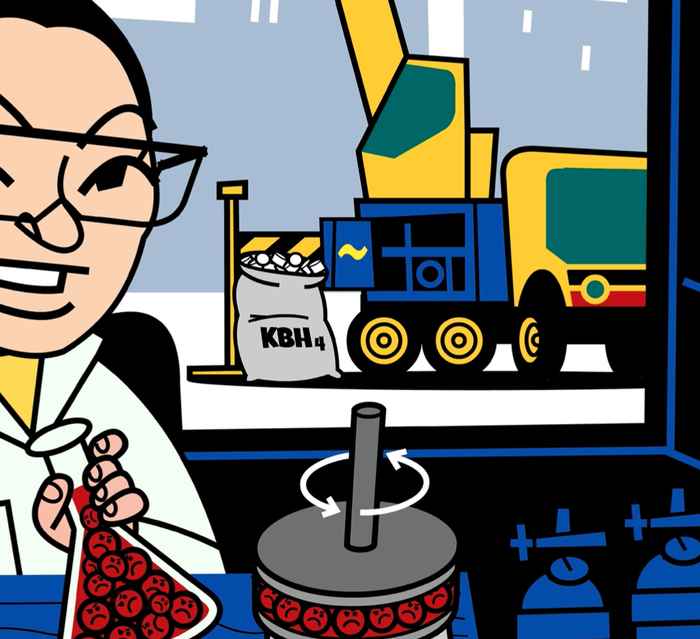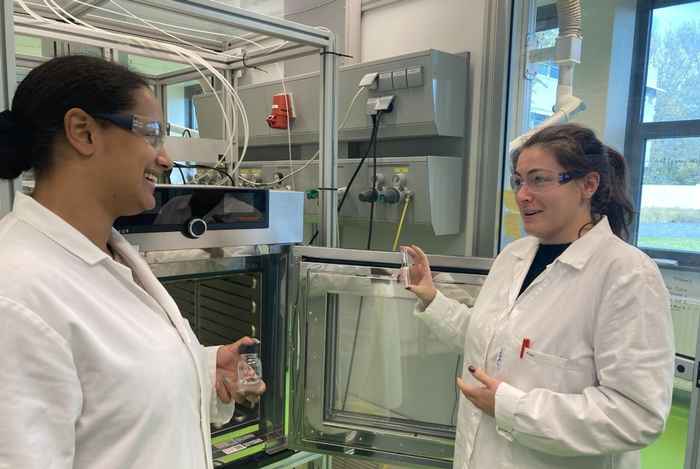Optimizing hydrogen storage in hydroborate salts
21 November 2022

Hydrogen may be the fuel of the future, but handling it in large quantities is no mean task. The key to its efficient transport and storage is to achieve a high energy density. Such is the case for compressed hydrogen gas and liquid hydrogen, but these forms are also highly explosive. Their application on industrial sites is strictly regulated and often restricted. These safety concerns can be overcome by binding hydrogen chemically as a solid salt, for example in alkali-metal borohydrides. Such salts provide a safe source of hydrogen when mixed with water, and the metaborate salt by-product can, in theory, be reprocessed and repurposed for hydrogen storage.
Alkali-metal borohydrides come in different flavours. Lithium borohydride (LiBH4) carries the most hydrogen by weight, but lithium is expensive, with competition from the batteries industry, and far too reactive. Sodium borohydride (NaBH4) seems a more popular (and cheaper) option, but its potential industrial application is hampered by the low solubility of its metaborate product. Potassium borohydride (KBH4) can be a viable alternative as its metaborate (KBO2) is more soluble.
Highly concentrated solutions
The problem in evaluating these different types of borohydrides is that their behaviour has mostly been determined in laboratory experiments with dilute solutions, which are often used as reducing reagents in chemical labs. Yet real-life application with sufficiently high energy density requires very high concentrations of the salt - as otherwise the ‘fuel’ contains a large excess of water that provides no energy. Ideally, industry aims at using pure powders, adding just enough water to release the hydrogen from the salt. However, since all these salts behave very differently at low and high concentrations, much of the research that is done on dilute solutions is irrelevant for industrial application.

A team of scientists from the UvA’s Heterogeneous Catalysis & Sustainable Chemistry research group, led by prof. Gadi Rothenberg, is working to develop high-performance catalysts for hydrogen generation. Such catalysts are crucial for achieving controlled release of hydrogen from concentrated borohydride solutions. Understanding of the behaviour of these solutions under real-life conditions is the key to the catalyst development process. Using rheology measurements, PhD student Fran Pope found that high concentrations of KBH4 gave more complex metaborate intermediates, showing oligomer-like properties. At low concentrations viscosity was maintained, implying spherical microstructures. Pure metaborate acted as individual particles with no change in viscosity, showing that the complex intermediates formed only in high concentration borohydride self-hydrolysis solutions.
The results, published in an open-access paper in ChemPhysChem and featured on the issue cover, form the basis of the team’s catalyst development project. This ‘Carbon-Free Fuels’ project, a collaboration with the Austrian Centre of Excellence for Tribology (AC2T) and industrial partner Electriq~Global, focuses on catalysts that can operate under real-life industrial conditions, such as for the 8 KWh hydrogen generator that was recently demonstrated by Electriq~Global in a hydrogen-powered crane.
Paper details
Frances Pope, Noë I. Watson, Antoine Deblais, Gadi Rothenberg: Understanding the Behaviour of Real Metaborates in Solution. ChemPhysChem, DOI: 10.1002/cphc.202200428 (open access)
See also
- Heterogeneous Catalysis & Sustainable Chemistry research group www.hims.uva.nl/hcsc
- Austrian Centre of Excellence for Tribology https://www.ac2t.at/en/
- Electriq ~ Global website https://www.electriq.com